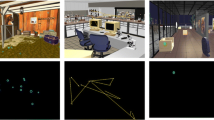Abstract
Data from human subjects recorded by an eyetracker while they are learning new faces shows a high degree of similarity in saccadic eye movements over a face. Such experiments suggest face recognition can be modeled as a sequential process, with each fixation providing observations using both foveal and parafoveal information. We describe a sequential model of face recognition that is incremental and scalable to large face images. Two approaches to implementing an artificial fovea are described, which transform a constant resolution image into a variable resolution image with acute resolution in the fovea, and an exponential decrease in resolution towards the periphery. For each individual in a database of faces, a hidden-Markov model (HMM) classifier is learned, where the observation sequences necessary to learn the HMMs are generated by fixating on different regions of a face. Detailed experimental results are provided which show the two foveal HMM classifiers outperform a more traditional HMM classifier built by moving a horizontal window from top to bottom on a highly subsampled face image.
Access this chapter
Tax calculation will be finalised at checkout
Purchases are for personal use only
Preview
Unable to display preview. Download preview PDF.
Similar content being viewed by others
References
Anstis, S. M. (1974). A chart demonstrating variations in acuity with retinal position. Vision Research, 14, pp. 589–592.
Ballard, D. H., (1991) Animate Vision, Artificial Intelligence journal, vol. 48, pp. 57–86.
Bandera, Cesar et. al. (1996) Residual Q-Learning Applied to Visual Attention, Proceedings of the International Conference on Machine Learning, Bari, Italy.
Desimone, R. (1991). Face-selective cells in the temporal cortex of monkeys. Journal of Cognitive Neuroscience, 3, pp. 1–8.
Friedman, A. (1979). Framing pictures: The role of knowledge in automatized encoding and memory for gist. Journal of Experimental Psychology: General, 108, pp. 316–355.
Henderson, J. M., & Hollingworth, A.. (1998). Eye movements during scene viewing: an overview. In G. W. Underwood (Ed.), Eye guidance while reading and while watching dynamic scenes, pp. 269–295. Amsterdam: Elsevier.
Henderson, J. M., & Hollingworth, A. (1999). High-level scene perception. Annual Review of Psychology, 50, pp. 243–271.
Kaelbling, L., Littman, M., & Cassandra, T. (1998). Planning and Acting in Partially. Observable Stochastic Domains, Artificial Intelligence.
Matin, E. (1974). Saccadic suppression: A review and an analysis. Psychological Bulletin, 81, pp. 899–917.
Moghaddam, B. (1998). Beyond Eigenfaces: Probabilistic Face Matching for Face Recognition, International Conference on Automatic Face and Gesture Recognition.
Nefian, A., and Hayes, M. 1999. Face recognition using an embedded HMM. IEEE Conference on Audio and Video-based Biometric Person Authentication, Washington, D.C. 1999.
Pentland, A. et al., View-based and Modular Eigenfaces for Face Recognition, IEEE Conference on Computer Vision and Pattern Recognition, 1994.
Puterman, M. (1994). Markov Decision Processes: Discrete Stochastic Dynamic. Programming, Wiley.
Rabiner, Lawrence R. (1989) A Tutorial on Hidden Markov Models and Selected Applications in Speech Recognition
Rayner, K. (1998). Eye movements in reading, visual search and scene perception: 20 years of research. Psychological Bulletin.
Riggs, L. A. (1965). Eye movements. In C. H. Graham (Ed). Vision and Visual Perception, pp. 321–349, New York: Wiley.
Rimey, R. D., & Brown, C. M. (1991). Controlling eye movements with hidden Markov models. International Journal of Computer Vision, November, pp. 47–65.
Rybak, I. A. et al. (1998) A Model of Attention-Guided Visual Perception and Recognition. Vision Research 38, pp. 2387–2400.
Samaria, F., & Young, S. (1994), HMM based architecture for face identification. Image and Computer Vision 12
Sela, G & Levine, D. M., (1997) Real-Time Attention for Robotic Vision, Real-Time Imaging 3, pp. 173–194, 1997.
Volkmann, F. C. (1986). Human visual suppression. Vision. Research, 26, pp. 1401–1416.
Yarbus, A. L. (1967). Eye movements and vision. New York: Plenum Press.
Author information
Authors and Affiliations
Editor information
Editors and Affiliations
Rights and permissions
Copyright information
© 2000 Springer-Verlag Berlin Heidelberg
About this paper
Cite this paper
Minut, S., Mahadevan, S., Henderson, J.M., Dyer, F.C. (2000). Face Recognition Using Foveal Vision. In: Lee, SW., Bülthoff, H.H., Poggio, T. (eds) Biologically Motivated Computer Vision. BMCV 2000. Lecture Notes in Computer Science, vol 1811. Springer, Berlin, Heidelberg. https://doi.org/10.1007/3-540-45482-9_43
Download citation
DOI: https://doi.org/10.1007/3-540-45482-9_43
Published:
Publisher Name: Springer, Berlin, Heidelberg
Print ISBN: 978-3-540-67560-0
Online ISBN: 978-3-540-45482-3
eBook Packages: Springer Book Archive




